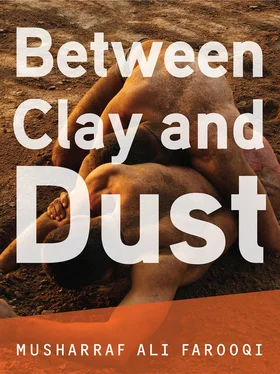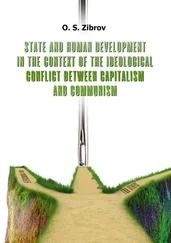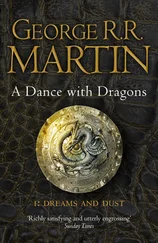Musharraf Ali Farooqi
Between Clay and Dust
The ruination of the inner city was attributed to time’s proclivity for change. It lay abandoned, half buried in and half surrounded by the squalor of shanty towns. New settlements cordoning it on three sides seemed to avoid the shadow of its sunken grandeur. Streets connecting new colonies skirted off its periphery. Links binding old and new neighborhoods were either never formed or broken at the start. The wide serpentine alley of high, arched gateways dividing its residential and artisan quarters looked strangely desolate.
The ravaging winds of Partition had left it unscathed. The turmoil that had seared the fiber of men and gored their souls had not touched this quiet habitation. There had been anxiety that things would be greatly changed, but later there seemed hope that the worst was over and life’s routines could now be renewed. Nobody expected that in Partition’s wake would follow a slow disintegration of values that would unravel the inner city. In a way, the inner city was always a cat’s cradle — a crisscross of life’s many faces, each sustained by the other. The strings of this cat’s cradle had not snapped but they had become hopelessly tangled.
The inner city had been emptied of most of its old inhabitants. Just as its walls had been stripped of their turquoise-colored mosaic panels, time’s ravages had forced into oblivion its generations of the dead, too. To answer the fierce demand for construction material during the last few years, the memory of those who had shaped the inner city was not only stripped of the tombstones that commemorated their existence, but also the bricks that marked their graves.
The disfigured architecture and worn, paved stones of the inner city still intoned its past splendor in broken whispers. There were a few enclaves where the last of its remnants were yet visible. Unconcerned and out of step with the currents of time, even after the recent changeful decade, these enclaves and those who inhabited them had continued to exist by exercising some power to resist change, or perhaps because no one found it worthwhile to remove them.
They had been left on their own and forgotten, and it occurred to some that the mist of oblivion would hang over them forever.
Ustad Ramzi was the head of a pahalwan clan and the custodian of a wrestler’s akhara. He was a man of frugal speech and austere habits, and appeared to some a stern man. His imposing stature, a heavyset jaw, and upturned whiskers only reinforced this impression. He was one of those men who do not accept the futility and emptiness of life, but who try continuously to give it meaning — a reflection of their own life’s purpose.
Fifteen years earlier, in 1935, he had won the highest wrestling title in the land, Ustad-e-Zaman. This title was at the heart of a long struggle between Ustad Ramzi’s clan and its rivals who had defended it for years. By winning the title, Ustad Ramzi had fulfilled the coveted dream of his clan elders. He had defended it many times since and cherished it as a sacred trust vouchsafed to the strength of his arms.
Recently, Ustad Ramzi’s world had been shaken by the abolition of the princely states whose nawabs and rajas had traditionally patronized the wrestling arts. Many smaller akharas had closed down in consequence. The two surviving akharas belonging to Ustad Ramzi and his rival clan had also experienced the bite of hard times. Trainee pahalwans continued to take instruction, but there were fewer of them than before. Only a few bouts had been organized in the past year, and they had not drawn many spectators.
The prevailing situation made the future of this sport look uncertain, at best. These circumstances, however, had not affected Ustad Ramzi’s unremitting adherence to his creed or checked his aspirations for the sport and its practitioners.
The akhara was a hallowed place for him, where a man made of clay came in contact with his essence. On the day he first put on the fighter’s belt and stepped into the akhara, Ustad Ramzi made the pahalwan’s traditional pledge to strive for the perfection of his body and soul until he returned to earth upon his death. The akhara, which his patriarchs had tended with their labor and sweat, was still the mainstay of his life. It had always been guided by the example of his elders, and as it was before, so it was now.
Ustad Ramzi had continued with his absolute ways in his diminishing sphere of influence where everything was predetermined, and every act, every gesture was of consequence. This consciousness had given a fatalistic decisiveness to his actions. People coping with the pressures of life after Partition, battling harsh circumstances with all the means in their possession — had neither the use nor sympathy for such intensity of purpose. Even those close to Ustad Ramzi sometimes found it difficult to understand or appreciate his motives. For many, Ustad Ramzi’s set outlook on life had turned from a virtue to an impediment.
Adjacent to Ustad Ramzi’s akhara was a private cemetery marked by an enclosure lined with cypresses, yews, and banyans. It was a relic of the time when it was not unusual for people to be buried where they had worked and spent their lives. Besides Ustad Ramzi’s ancestors, other pahalwans who had upheld the art’s strict tenets were also honored by being buried there.
Ustad Ramzi did not allow sweepers to enter the cemetery for fear of polluting the sanctity of its grounds; instead, he swept it himself every week with a broom of palm fronds. He never entered it without making ablutions. He kept the cemetery rimmed by rose boughs as a sign of devotion to the memory of his elders whose lives had been lived in strict conformity with their creed. He always experienced a deep sense of harmony in that place.
The graves were not laid symmetrically, and the ground was a little uneven and sloped to one side. In a corner at the acclivity of the slope, Ustad Ramzi had placed two stones and surmounted them with a marble slab to improvise a bench where he kept his gardening tools. Sitting there he could see the spot in the cemetery where lay his own unfilled grave. He had made it several years earlier and exulted in the anticipation that the day he was laid there, his life, too, would have conformed to that of his elders’ existence and become a part of it.
In recent days, the enclosure that housed Ustad Ramzi’s akhara and the adjacent cemetery was jestingly referred to as the Elephants’ Graveyard — that mythical spot in a forest to which elephants retire at the approach of death. The caricature of the pahalwan as a dying beast and the implied suggestion that in the eyes and minds of people the pahalwan’s art and his world were doomed, were not lost on Ustad Ramzi. The wedge of antipathy that had slowly been driven between him and the world had left Ustad Ramzi unruffled; he had learnt to take in disparaging words without feeling outrage.
When the akhara was allotted to Ustad Ramzi’s ancestors, its five buildings were used as living quarters by pahalwans and their retainers. Only three buildings stood now, in varying stages of ruin. One had been locked up after its roof caved in. For some years swallows had nested there, along with the peacocks kept in the enclosure by Ustad Ramzi’s father to exterminate the snakes that once infested the property. One building was used by the trainees. Ustad Ramzi and his younger brother Tamami lived in the other building which overlooked the akhara.
There was an age difference of twenty years between Ustad Ramzi and Tamami, and their temperaments and outlook on life were also greatly at variance. Tamami was of a frivolous nature. Unlike Ustad Ramzi, who took a nobler view of his art and creed, Tamami was more interested in the celebrity conferred by the title. While he was mostly neglectful of his duties as a pahalwan and had won neither honor nor renown for himself, he never let an opportunity pass to impress upon his friends and acquaintances that he was the scion of the clan in possession of the title. Tamami behaved as if he were himself the titleholder.
Читать дальше












